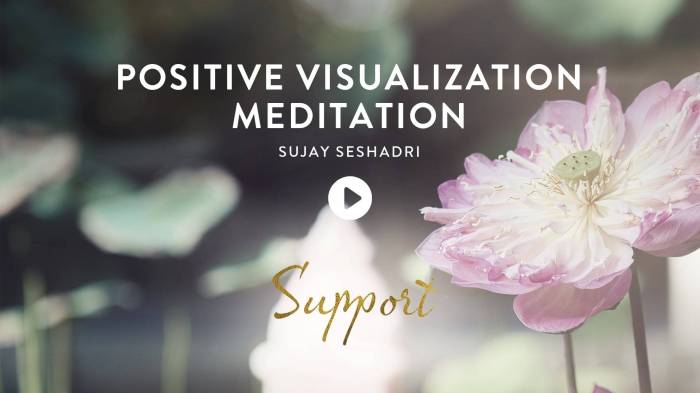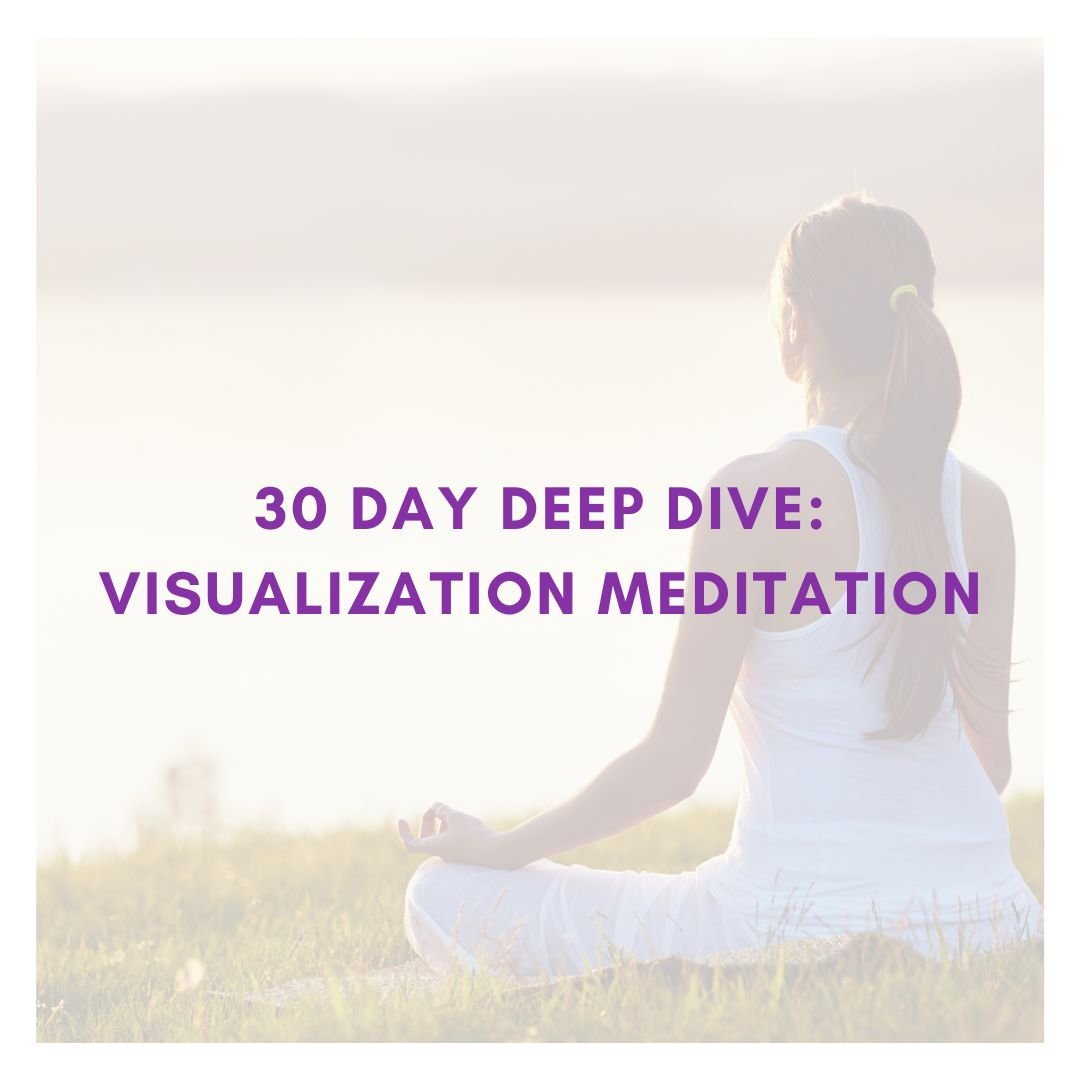Embark on a journey through 7 Visualization Techniques for Meditation Success, where we uncover the secrets to enhancing your meditation practice with engaging and effective visualization methods. Dive in to discover how these techniques can transform your mindfulness experience!
Visualization is a powerful tool that can take your meditation practice to new heights, offering a unique way to deepen relaxation, focus, and spiritual connection. Let’s explore these techniques together and unlock the full potential of your meditation sessions.
Introduction to Visualization Techniques

Visualization techniques involve the practice of creating mental images or scenarios to help focus and guide the mind during meditation. This powerful tool can enhance the meditation experience by engaging the senses and emotions, making the practice more immersive and effective.Visualization is crucial for meditation success as it helps in calming the mind, reducing stress, and enhancing concentration. By visualizing peaceful and positive images, individuals can create a sense of tranquility and inner peace, allowing them to achieve a deeper state of meditation.
Benefits of Incorporating Visualization Techniques
- Enhanced Focus: Visualization techniques help in sharpening focus and attention during meditation, enabling individuals to stay present and engaged in the practice.
- Emotional Regulation: By visualizing calming and soothing scenes, individuals can manage their emotions better, leading to a more peaceful state of mind.
- Stress Reduction: Visualization techniques can aid in reducing stress and anxiety levels by creating a mental escape to a serene and tranquil environment.
- Creative Expression: Visualizing different scenarios during meditation can unlock creativity and imagination, fostering a sense of inspiration and innovation.
- Sensory Stimulation: Engaging the senses through visualization can heighten the meditation experience, making it more vivid and immersive.
Guided Imagery
Guided imagery is a powerful visualization technique that involves creating detailed mental images or scenarios guided by a facilitator, recording, or script. Unlike other visualization techniques where individuals rely solely on their imagination, guided imagery provides a structured framework to follow during meditation.Guided imagery can transport individuals to different scenarios or settings, such as a peaceful beach, a serene forest, or a healing garden.
These vivid mental images help to engage multiple senses and evoke strong emotions, making the meditation experience more immersive and impactful.
Examples of Scenarios for Guided Imagery
- Imagining yourself walking along a sandy beach, feeling the warmth of the sun on your skin and hearing the gentle sound of waves crashing.
- Visualizing a lush green forest with sunlight filtering through the canopy, breathing in the fresh scent of pine and earth.
- Picturing a tranquil garden with colorful flowers, feeling a sense of peace and relaxation wash over you.
Guided imagery can deepen the meditation experience by helping individuals focus their attention, relax their mind and body, and tap into their subconscious thoughts and emotions. By following a guided script or recording, individuals can let go of distractions and fully immerse themselves in the visualization, leading to a more profound state of relaxation and self-discovery.
Body Scan Visualization
Body scan visualization is a meditation technique that involves mentally focusing on different parts of the body, one at a time, to bring awareness and relaxation to each area. This practice is often used to promote mindfulness and reduce stress.
Process of Body Scan Visualization
During body scan visualization, practitioners typically start by bringing their attention to their toes and gradually work their way up through each body part, paying attention to any sensations or tension they may feel. This process helps individuals become more in tune with their bodies and can help release physical and emotional tension.
Benefits of Focusing on Different Parts of the Body
- Enhanced Body Awareness: By focusing on individual body parts, individuals can develop a deeper connection with their bodies and better understand areas of tension or discomfort.
- Stress Reduction: Bringing attention to different body parts can help release physical tension and promote relaxation, reducing overall stress levels.
- Promotes Mindfulness: Body scan visualization encourages individuals to stay present in the moment and cultivate mindfulness by focusing on sensations in each body part.
Enhancing Relaxation and Mindfulness
- Deep Relaxation: Body scan visualization allows individuals to relax each body part systematically, promoting a sense of deep relaxation throughout the entire body.
- Improved Mindfulness: By practicing body scan visualization regularly, individuals can enhance their overall mindfulness and awareness of bodily sensations, thoughts, and emotions.
- Stress Management: The relaxation and mindfulness cultivated through body scan visualization can help individuals better manage stress and respond to challenging situations with greater calmness.
Nature Visualization: 7 Visualization Techniques For Meditation Success

Nature visualization in meditation involves mentally immersing oneself in natural settings to enhance the meditation experience. By visualizing various natural elements, individuals can create a sense of calm, peace, and connection with the environment around them.
Different Natural Settings for Visualization
- Forest: Visualizing a dense forest with tall trees, chirping birds, and a gentle breeze can evoke feelings of tranquility and grounding.
- Beach: Imagining a serene beach with the sound of waves crashing, warm sand beneath your feet, and the sun setting on the horizon can promote relaxation and mindfulness.
- Mountains: Picture yourself surrounded by majestic mountains, clear blue skies, and crisp mountain air to instill a sense of awe and inner strength.
Improving Meditation Outcomes with Nature Visualization, 7 Visualization Techniques for Meditation Success
Connecting with nature through visualization can have several benefits for meditation practice:
- Reduced stress and anxiety: Immersing oneself in natural settings can help calm the mind and reduce stress levels, leading to a deeper sense of relaxation during meditation.
- Enhanced focus and concentration: Visualizing natural elements can improve focus and concentration by providing a soothing and peaceful backdrop for the mind to rest upon.
- Increased sense of connection: Feeling connected to nature through visualization can foster a sense of unity with the environment and promote feelings of harmony and well-being.
Color Visualization
Color visualization is a powerful technique used in meditation to enhance focus, relaxation, and overall well-being. By incorporating different colors into your visualization practice, you can tap into the emotional and energetic effects that each color has on the mind and body.When meditating, different colors can evoke specific emotions and impact energy levels. For example, blue is often associated with calmness and tranquility, making it ideal for promoting relaxation during meditation.
On the other hand, yellow is linked to feelings of joy and positivity, which can help boost mood and energy levels.
Benefits of Color Visualization in Meditation
- Red: Visualizing the color red can help increase energy and motivation during meditation sessions.
- Green: Green is known for its healing properties and can promote a sense of balance and harmony.
- Purple: Purple is often used to enhance spiritual awareness and connection during meditation practices.
Symbol Visualization

Symbol visualization is a powerful technique used during meditation to enhance focus, deepen spiritual connection, and cultivate mindfulness. By incorporating symbols into the practice of visualization, individuals can tap into the subconscious mind and access deeper levels of awareness.
Common Symbols in Meditation
Symbols used in meditation practices vary across different cultures and belief systems. Some common symbols include:
- The Lotus Flower: Symbolizing purity and enlightenment, the lotus flower is often used to represent spiritual growth and transformation.
- The Om Symbol: A sacred sound and spiritual icon in Hinduism, Buddhism, and other traditions, the Om symbol is believed to encompass the essence of the universe.
- The Mandala: A geometric pattern representing the universe, the mandala is used for meditation and spiritual healing.
- The Tree of Life: A symbol of interconnectedness and growth, the tree of life is often used to symbolize the cycle of life and the connection between all living beings.
Deepening Spiritual Connection and Mindfulness
Symbol visualization can deepen spiritual connection by providing a focal point for meditation and contemplation. By focusing on a symbol during meditation, individuals can align their thoughts, emotions, and intentions with the deeper meaning and energy associated with the symbol. This practice can enhance mindfulness, increase self-awareness, and promote a sense of inner peace and harmony.
Future Self Visualization

Visualizing one’s future self during meditation involves creating a detailed mental image of the person you aspire to become. This can include envisioning your future accomplishments, goals achieved, and overall happiness and success in various aspects of life.Envisioning your future self through visualization can have numerous benefits. By picturing yourself as a successful and fulfilled individual, you are setting a positive intention for your future.
This can help boost your confidence, increase motivation, and enhance your overall well-being. Additionally, visualizing your future self can serve as a powerful tool for goal setting and manifestation, as it allows you to align your thoughts and actions with your desired outcomes.Future self visualization has the potential to inspire personal growth by providing a clear vision of where you want to go and who you want to become.
It serves as a guiding light that can help you make decisions, overcome obstacles, and stay focused on your goals. By regularly visualizing your future self during meditation, you are actively shaping your mindset and beliefs, paving the way for positive change and transformation in your life.
Benefits of Future Self Visualization
- Enhanced motivation and goal setting
- Increased confidence and self-belief
- Alignment of thoughts and actions with desired outcomes
- Clarity and focus on personal growth and development
- Positive mindset and belief in future success
End of Discussion

As we conclude our exploration of 7 Visualization Techniques for Meditation Success, remember that the key to a fulfilling meditation practice lies in your ability to harness the power of visualization. By incorporating these techniques into your routine, you can elevate your mindfulness journey and achieve greater peace of mind. Embrace the transformative power of visualization and watch your meditation practice flourish!